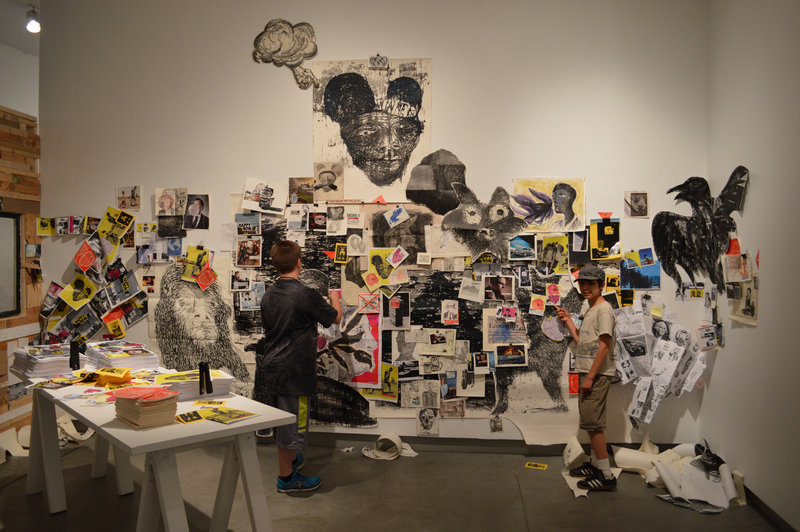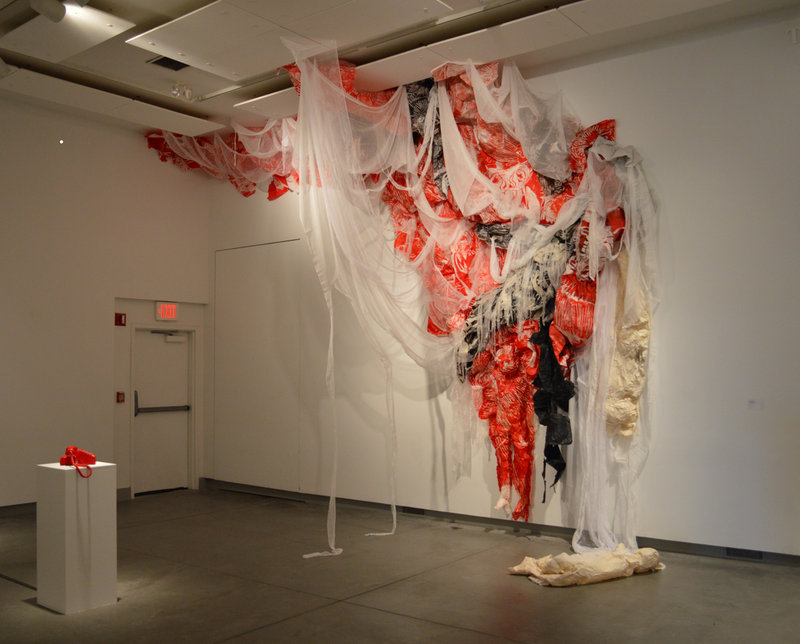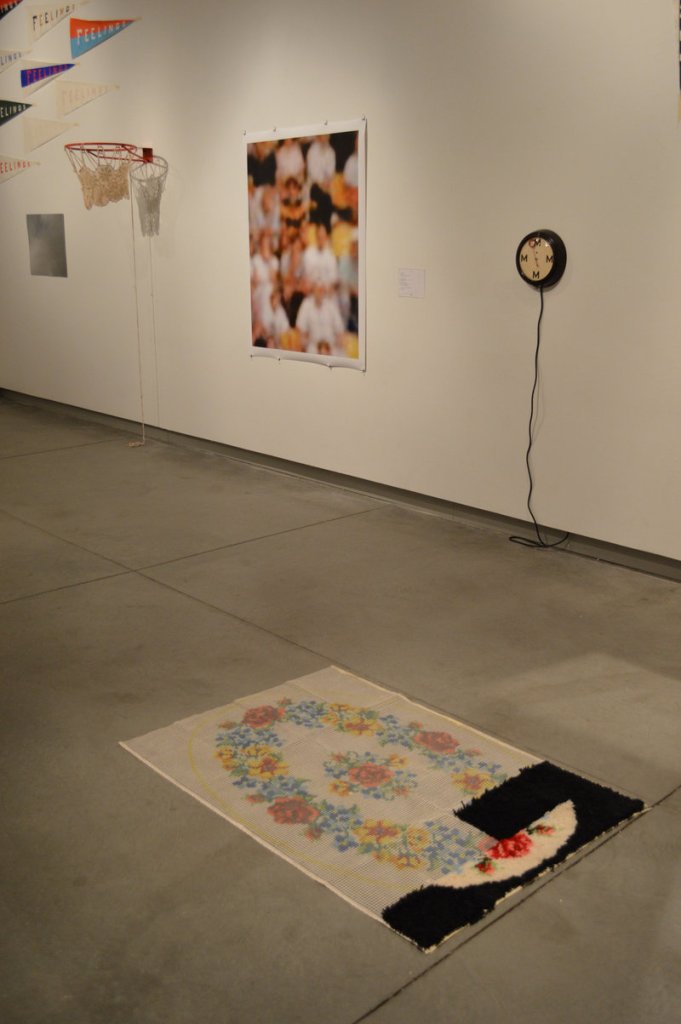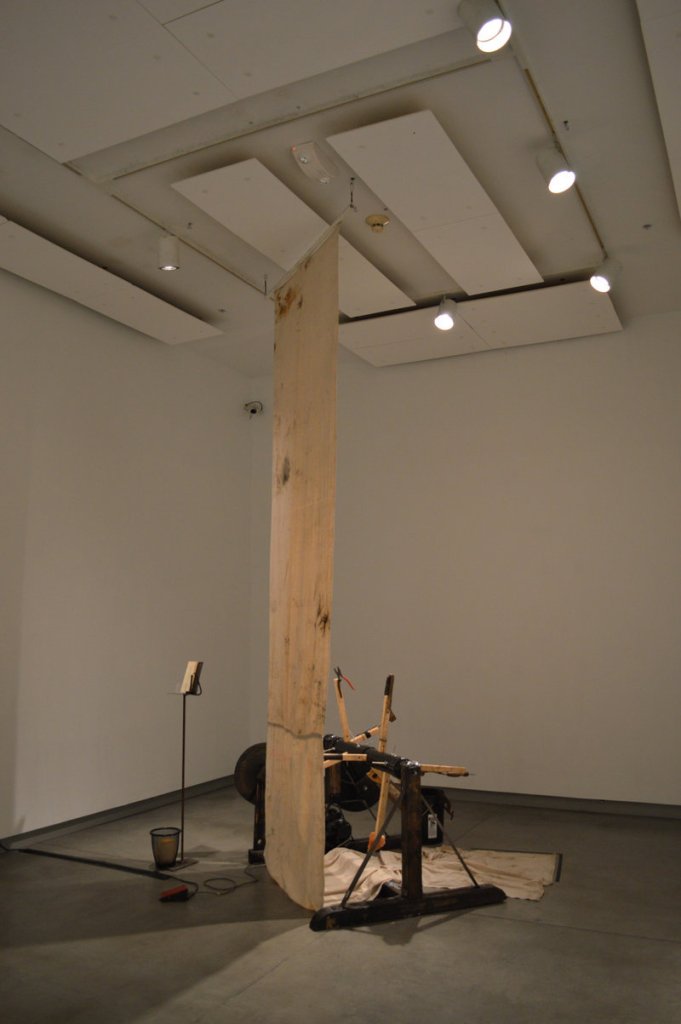The unsung – but very real – depth of Maine’s art education communities has a somewhat strange effect on Maine College of Art. As the apparent crown jewel, MECA’s reputation enjoys a certain sparkle. The flip side is that this raises expectations.
You might think a Master of Fine Arts show comes after all the lessons, but there is no better art education experience than learning about the art world pressure cooker from within.
On the big stage, details matter. So when you consider that this work is by MFA candidates who have to defend it as their degree-earning culmination, things like questionable installation aspects don’t fade into the woodwork.
For example, one of my favorite works is an installation sculpture of 50 or so strands of minimalist-flavored, geometrically arranged string and twine by Gregor Roth. The reason why I like it, however, has to do with the strange space created by the drywall placed on the cement floor of the gallery. It creates a hyperbolically theatrical stage space seemingly at odds with such an ethereal work.
The drywall floor goads the viewer mostly because of the footprints already there. Are they the record of the artist’s installing the piece? Did someone wrongfully sully this installation? Or are we supposed to explore the space? And if so, do we even want to explore it?
While these are interesting enough questions, it looks like the drywall was a last-minute solution by Roth to attach his thesis project to the floor.
Right across from Roth’s piece is an installation by Brian Dimmock featuring a machine that spins a roller from which arms protrude with a hammer, a hatchet, a saw, wax hands with nails, etc. The idea seems to be that the viewer will step on the foot pedal to start the machine, and then the shadows of these scary things will be projected onto a large cloth that hangs in front of the piece.
But the cloth is too slender and the piece is lit directly from behind, so the scary instruments simply look like shadow lines on the cloth – if you even notice the projection in the brightly lit room (and I did not until it was pointed out to me).
Strangely, I think Dimmock’s anti-machine piece works well as a still sculpture. My guess is that this also is an issue of installation that makes the piece something other than what it was intended to be.
Nevertheless, I think this is an interesting show, and that these MFA candidates generally rise to an worthy level of sophistication.
But the show is a mess, and suffers for it.
Ben Severns is one of the few who rises above the chaos. In fact, his large black sticker on the front window that reads “Pardon our mess” becomes genuinely funny only as you leave the gallery. Conversely, his “A Fair Warning” is a hilarious work that greets the entering viewer. It’s a neon sign hanging above the front desk that reads “EVIL” in white and then, as you approach, flashes “NOT” (in red, like the “no” in “no vacancy” signs).
But Severns also knows how to use conceptual art to stick a dagger in your heart. His monument to children killed by warring Americans in Iraq is just a few reams of cheap paper from Staples with the children’s myriad names scrawled on them in Sharpie piled as an afterthought on a tiny, makeshift table.
The appearance of the main gallery is the main problem. It was a mistake to place Maria Liebana’s intentionally grotesque, fancy handbag sculptures in the middle of the floor; there, they become infectiously illegible noise. They might succeed in a swanky setting, but you can’t isolate them amongst the visual cacophony.
I was particularly impressed by the favela power and logic of Sandra Lapage’s huge paper and cloth installation exploding upward and outward from a red figure – like the dematerialization of a human body by the violence of its representations.
Carlos Pileggi’s (very hip) crammed print studio installation has a similar logic – and with even more South American flavor.
The best moment of the show is viewing Pileggi’s studio-as-mad-political-scientist-laboratory installation through the window of Adam Robertson’s decidedly similar but American version of the psychologically-revealing shack. Robertson’s has a shelter-as-opposed-to-real-estate feel with a post-apocalyptic edge that is unfortunately impossible to remove from Maine’s recently and famously dispossessed hermit.
There are a couple of art-as-catharsis installations that don’t interest me, because I like art for its public culture rather than its self-involvement.
Masterfully combining digital travel with technological craftsmanship, Jeffery Campbell’s Photoshop-stitched landscapes crept up on me. They combine images of things that aren’t – or can’t be – together in the real world. While they look culled from Google Earth, some include things like military elements (missile sites, ships, etc.) that we expect to be scrubbed from the Internet.
My favorite piece in the show, however, is a hooked rug by Marina Eckler. It appears to be a found, incomplete rug about one-eighth through its simple, decorative pattern. Eckler then completed a similar amount – but only in the black of the background – before she gave it up.
Her echoing the first hooker’s lack of completion is impossibly more clever and revealing than if she had finished the rug.
I like that Severns and Eckler bookend the show. While Severns’ brooding wit feeds on open cultural wounds, Eckler’s transcendentally positive puns cheerlead maternal feminism, and feature a rare flare for the genuinely iconic.
In short, this year’s MFA show contains a largely worthy crop of blossoming artists. I just hope the curatorial presentation of their work doesn’t take too much of a bite out of their achievement.
Freelance writer Daniel Kany is an art historian who lives in Cumberland. He can be contacted at:
dankany@gmail.com
This column was updated at 8:22 a.m. Sunday May 19 to correct the spelling of Sandra Lapage’s last name.
Send questions/comments to the editors.






Success. Please wait for the page to reload. If the page does not reload within 5 seconds, please refresh the page.
Enter your email and password to access comments.
Hi, to comment on stories you must . This profile is in addition to your subscription and website login.
Already have a commenting profile? .
Invalid username/password.
Please check your email to confirm and complete your registration.
Only subscribers are eligible to post comments. Please subscribe or login first for digital access. Here’s why.
Use the form below to reset your password. When you've submitted your account email, we will send an email with a reset code.